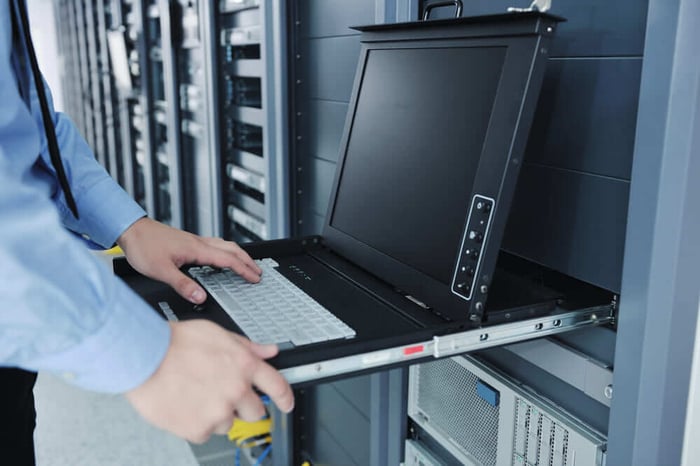“How Many Access Points Do I Need?” – Get Your Answers Here
 High-quality WiFi coverage is a must for any organization in this day and age. Poor coverage can lead to dead zones, slow speeds, dropped connections, and frustrated users. As a result, productivity and efficiency can suffer. The use of access points (AP) can help expand your WiFi coverage throughout your office space to help prevent these issues.
High-quality WiFi coverage is a must for any organization in this day and age. Poor coverage can lead to dead zones, slow speeds, dropped connections, and frustrated users. As a result, productivity and efficiency can suffer. The use of access points (AP) can help expand your WiFi coverage throughout your office space to help prevent these issues.
However, you'll need to determine precisely how many wireless access points (WAPs) you need to ensure proper WiFi coverage.
The Benefits Of Having Multiple Access Points On Your Network
Businesses that depend solely on a single access point may end up dealing with slow speeds, unreliable connections, and other issues. This is especially true if the AP isn't placed in an ideal spot to cover the entire space. It's why you should use multiple APs.
With multiple APs, you can keep your network running smoothly and optimally regardless of where your users are or what devices they're using. The following are some of the reasons why you should use multiple APs throughout your space:
Provides Additional Bandwidth And Coverage: Larger spaces need more bandwidth to handle the extra strain of multiple users and devices. The use of multiple access points will provide the additional bandwidth required to keep your network running smoothly by allowing various devices to connect to the same network.
Additionally, having multiple access points can help expand coverage throughout your space by providing more connection points for users to connect to.
Helps Improve The Overall Network Reliability And Performance: The odds are your employees need a reliable network connection to do their job. Having multiple APs can enhance the performance and reliability of your network by allowing multiple users to access the same network without overloading it.
Additionally, with multiple APs, you can avoid overloading one specific access point and ensure that all your users have a reliable connection. As a result, the performance of your WiFi won't dip either, meaning that your employees can stay productive without any hitches.
Ensures Your Network Is Always Up And Running: With multiple APs, you can create a mesh network (if your AP brand and model supports meshing). A mesh network is a wireless network that consists of multiple APs.
This type of network is very reliable and efficient because if one access point goes down, the other access points will continue to provide WiFi coverage. This ensures your network is always running, even if one access point goes down.
Factors To Consider When Determining The Number Of WAPs
If you don't have enough WAPs set up throughout your office, your WiFi coverage may not reach where you need it to. With that in mind, the following are a few factors that you should account for to determine the specific number of APs you need:
- Size Of The Area: The size and layout of your office will largely dictate how many APs you need. Calculate the total square footage to determine the coverage area that is required. Then, using the coverage specified by the AP you plan to use, you can calculate the number of APs you need to cover the entire space.
Layout Of The Area: Once you know the size of the area, it's essential to consider any physical obstructions that could limit the reach of your WiFi signal. Certain building materials used in your walls may obstruct your signal.
For example, reinforced concrete will be more of an issue than drywall. On top of that, consider the actual layout of the space. Reinforced concrete walls won't be an issue if your office is a wide open space. However, your walls will pose more of a problem if your space is L-shaped or U-shaped.
- The Number Of Connecting Users: The number of users in your office will also affect the number of APs you need. If too many users try to connect to the same network, it will cause your network to slow down. To ensure your network remains stable and fast, you'll need multiple APs to distribute the load among them.
- The Number Of Connected Devices Per User: In addition to the number of users, you should also consider how many devices each user has.
With more people using multiple devices, from work computers to smartphones and other IoT devices, you will need more access points to ensure everyone has the coverage they need. Generally speaking, most employees use an average of three devices. - Type Of Connecting Wireless Devices:Depending on the type of devices that are connecting to your network, you may need an access point with a higher capacity.
For example, if your office is full of devices that , such as video streaming devices, video collaboration, or high-resolution desktops, you may need an access point with higher performance capabilities.
Type Of Wireless Network: Certain types of networks may also require more access points for optimal coverage. For example, an enterprise-level network will require more access points than a basic home network.
- Traffic Requirements Of The Network: The type of traffic passing through your network will also determine how many access points you need. If you have a lot of large data files or streaming video, you may need to add additional access points to ensure your network can handle the increased traffic.
- Location Of The Access Points: Finally, the location of your access points can also play a role in determining how many you need.
For example, you'll need to consider the placement of the access points in relation to the area that needs coverage, as well as any obstructions that may interfere with the signal. Placing an AP on the floor in the corner of two concrete walls will significantly limit its reach.
How Many WAPs Do You Need?
In addition to keeping the previously listed factors in mind, the following are a few general rules that you should follow to help you determine precisely how many WAPs you'll need for your organization:
- For Every 1,000 Square Feet (93 m2) Of Coverage Area: Generally speaking, you should have one AP for every 1,000 square feet (93 m2) of coverage area.
- For A Small Office Or Retail Space: For a small office or retail space of 2,000 square feet (186 m2), you need two APs.
- For A Larger Office Or Warehouse Space: For a larger office or warehouse space of 10,000 square feet (929 m2), you would need 10 access points.
Finding The Most Strategic Locations For Your WAPs
Once you have figured out how many you need and you buy your WAPs, it's essential that you set them in the most strategic locations possible. To do this, you should consider the following:
- Place the access point in a central location for equal coverage throughout your office.
- Avoid placing the access point near windows, doors, or other objects that can block, bounce, or absorb radio signals.
- Consider using multiple access points for optimal coverage if you have a large office.
Can You Have Too Many WAPs
The last thing you want is to not have enough APs to provide the WiFi coverage you need. As such, you might think it wise to set up a few more APs than required. However, too many APs can be detrimental to your wireless coverage. The following are a few of the reasons why it's better not to use more APs than needed:
Interference
Too many APs running in close proximity can cause interference, resulting in slower speeds and poor connection quality. Interference can happen as a result of overlapping channels and signal strength.
Security Risks
Having too many WAPs can also create security risks. An attacker could easily hop from one AP to another, making it difficult to trace their activity. Additionally, if you have too many APs, they may not be configured properly, leaving your network vulnerable to attack.
Increased Costs
Setting up and running multiple WAPs can be more expensive than you think. The increased electricity costs and the need to upgrade your network switches to accommodate more APs can add up quickly. The cabling and installation costs for multiple WAPs can be relatively high as well. Not to mention that your cooling bills can also increase due to the additional hardware.
Complexity
Setting up multiple WAPs can be a complex process and managing them can also be a challenge. You have to ensure that the APs are properly configured and that you have the correct settings in place for optimal performance. This can get pretty challenging if you have too many APs.
Ensure Your Business Runs Smoothly By Assessing Your Network’s Connectivity
At Hummingbird Networks, our team of experienced network engineers understands how important it is for your business to have reliable and secure wireless connectivity.
We can help you assess your current network environment, determine the optimal number of WAPs you need, and ensure that your APs are properly configured for maximum performance and security. With our comprehensive network assessments and wireless solutions, you can rest assured that your business will run smoothly and securely.
Need help determining how many access points your specific situation requires? Connect with our wireless networking experts today.




